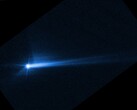On May 26, 2025, the imaging team of NASA’s Perseverance rover, using the rover’s Mastcam-Z instrument, captured 96 images at a location believed to be one of the oldest ever explored by the robotic vehicle. The science team calls the location “Falbreen.” The images were stitched together to produce a panorama that shows Mars clear as day.
One key feature seen in the image is a large rock geologists call a “float rock.” It is called a float rock because geologists believe that the rock was formed elsewhere and transported by factors such as a landslide, water, or wind. This rock appears to be resting on a dark, crescent-shaped sand ripple, located about 14 feet (4.27 meters) from the rover and just to the right of the mosaic’s center.
Another observed detail is a band, just past the mosaic’s center, stretching from one side to the other. It demarcates the lighter-toned rocks, which are nearer to the rover, from the darker-toned ones, seen farther away. The lighter rocks are rich in olivine, while the darker rocks are believed to be considerably older rocks rich in clay.
Perseverance analyzed the rocks and soil at Falbreen by drilling into the ground. This drilling action left an abrasion patch seen as the bright white circle just left of the center and near the bottom of the image. NASA’s Perseverance rover, which landed on Mars on February 18, 2021, continues to provide more understanding of the planet, paving the way for future human missions.


































